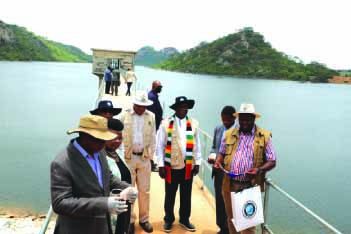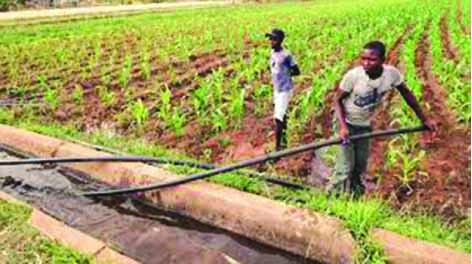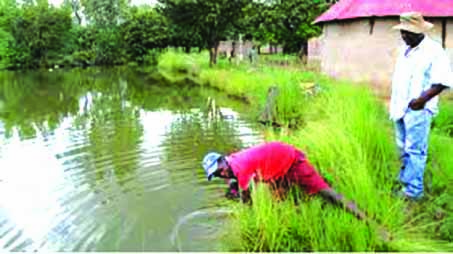
The ManicaPost

Samuel Kadungure
Senior Reporter
THE centrality of water in pursuit of Sustainable Development Goals (SDGs) cannot be overstated considering its contribution to various economic sectors like agriculture, energy, health, manufacturing and tourism, among others.
Provision of ideal water infrastructure like dams is therefore fundamental to the elimination of poverty and hunger.
It is also critical in ensuring good health and economic vibrancy in Manicaland and beyond.
It is against this background that the Second Republic fast-tracked the construction of Marowanyati Dam in Buhera and Muchekeranwa Dam on the boarder of Manicaland (Makoni District) and Mashonaland East Provinces.
The water bodies have set the province on a solid development trajectory.
The dams are climate-proofing agriculture and reducing heavy reliance on rain-fed farming, which has always been a recipe for disaster during droughts.
Indeed, water scarcity has a huge impact on food production.
Water is an indispensable ingredient to agricultural production and without the precious liquid, farmers are not able to grow their crops and feed their animals.

President Emmerson Mnangagwa is joined by other senior Government officials during the commissioning of Marovanyati Dam in Buhera. The dam is providing water for Murambinda Town Board, Dorowa Mine and Sabi Star Lithium Mine, as well as irrigation water for surrounding communities
Water insecurity translates to food insecurity, and dam construction therefore becomes even more important for the province, especially considering that its economy is largely hinged on agriculture.
Marovanyati was fast-tracked to completion by the Second Republic between 2017 and 2020 as part of strategic and wider efforts to foster reliable access to irrigation water for communities where the impact of climate change is being felt.
After 10 years of deferment under the old regime, President Emmerson Mnangagwa’s administration allocated funds for the dam’s construction.
The total cost of the project was US$33,2 million.
The project was supervised by the Zimbabwe National Water Authority (Zinwa).
The multi-purpose reservoir has storage capacity of 50 million cubic litres, an amount that will increase as the dam matures.

Murambinda B Irrigation Scheme which draws water from Marovanyati Dam in Buhera has seen food security increasing for the communities within the vicinity of the water reservoir
Marovanyati Dam is located on the Mwerihari River, a perennial stream with an annual flow of 182 million litres.
The dam provides sufficient water to ameliorate industrial and agricultural development in the district and has the potential to transform the lives of the agricultural communities that live along its banks.
The growth of Murambinda, which was given town board status last year, will not encounter any obstacles in the near future due to the availability of water from Marovanyati dam.
Buhera RDC chief executive officer, Dr Emily Chibvongodze said Marovanyati Dam provides water for domestic and industrial use in Murambinda.
“The capacity of Marowanyati Dam is 50 million cubic metres with the dam providing water for Murambinda Town Board, Dorowa Mine and Sabi Star Lithium Mine, as well as irrigation water for surrounding communities.
“The dam therefore has the capacity to meet the water demands for Murambinda,” she said.
“We thank Government for the completion of Marovanyati Dam, which means more development for Murambinda and communities downstream. Numerous investors have expressed interest in fisheries, conferencing and hospitality, wildlife and constructing hotels around the dam,” said Dr Chibvongodze.
She said Buhera RDC has taken the responsibility of planning economic activities around the dam.
Government also has set aside $406 million for the development of a commercially-run centre pivot irrigation system downstream the dam as part of the rural transformation strategy.
The first phase will see two irrigation schemes – Guwanda (100ha) and Kwarire (400ha) being set up this year.
The other projects earmarked for Marowanyati include Muguta, Chipudzana, St Alban’s, Nyashanu and Bhidhiri-Chiwenga Irrigation Schemes.
The projects will see a cumulative 1 250 hectares of agricultural land getting under centre pivot irrigation to improve food and nutritional security, create employment and transform livelihoods in the drought-prone district.
On the other hand, the construction of Muchekeranwa, formerly known as Causeway Dam, started in 2016 and was finished in December 2020 after the New Dispensation stepped in.
Muchekeranwa is located on the Macheke River, a major tributary of the Save River.
It has a carrying capacity of 75 million cubic metres and will irrigate about 2 250 hectares.
In Makoni, the dam will target small-holder commercial farmers, as well as Chiduku-Ngowe (44ha) and Romsely (500ha) Irrigation Schemes; with the aim of sustaining agricultural projects, economic growth and development.

The Presidential Command Fisheries Programme has seen farmers in Buhera drawing water from Marovanyati Dam and setting up ponds for fish farming to supplement their incomes
The dam also hosts the Presidential Community Fisheries Scheme.
Commercial farmers in Makoni started fully utilising water from the dam in 2021, and has since then contributed significantly to Manicaland’s attainment of its 9 500ha wheat target last year.
A total of 5 200ha were planted by the farmers in Makoni, most of whom draw irrigating water from Muchekeranwa Dam.
Mr Denford Mutwiwa, who became the first farmer to draw irrigation water from the dam, now farms all-year-round.
“When the dam was completed, we swiftly put an irrigation mainline to all the fields.
“The irrigation network has 7kmx25mm PVC pipes pumped by a 120-horse-power pump.
“We can now plant up to 500ha at a go since all the fields are under centre pivots.
“Altogether we have 10 centre pivots which can irrigate between 10 and 55ha. The dam has given us access to plenty of water,” he said.
Another farmer, Mr Zvikomborero Nyabadza, installed a 12km pipeline to draw water from the dam to his Moresta Farm.
All these projects were designed to enhance rural health standards, promote education, improve living standards and promote income-generating activities in line with the National Development Strategy (NDS1).



